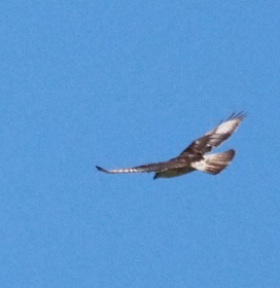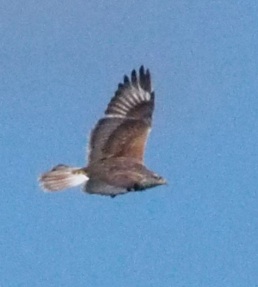A practical guide to bird watching in Sonoma County, California
(Unless otherwise indicated, all phone numbers are in the 707 area code)
A practical guide to bird watching in Sonoma County, California
(Unless otherwise indicated, all phone numbers are in the 707 area code)



A fairly large (19-25 inches head to tail, wingspan 43-57 inches), chunky, comparatively short-tailed Hawk. The broad, rounded wings and short, broad tail, apparent in flight, are typical of this bird and the genus Buteo in general.
Highly variable plumage, with a number of named variations and light and dark morphs of most typical plumage patterns. Red-tailed Hawks therefore can be confusing, especially to beginning birders and casual birders, but they are usually identifiable by size, shape, and habit, if not immediately by coloration. That said, the typical adult bird in Sonoma County is mostly dark brown above (but often with a subtle, variable pale or slightly rufous mottling) with a dark head and rufous tail, often somewhat paler at the base. From below, usually dark at the the throat, pale at the breast and with a pale belly, variably streaked with dark brown. The tail is considerably less obviously red from below, unless well-lit. Young birds show more streaking on the breast and belly than adult birds, especially around the lower belly (they are often described as having a “belly band”). Note, however, that birds of populations in the Eastern United States often (although not always) retain the belly band into adulthood. Young birds have a pale iris, adult birds an all-dark eye. Young birds are paler at the base of the tail than adults and show a distinctive pattern of paleness at the base of the primaries as well (photos below), both of which can suggest a young Ferruginous Hawk (Buteo regalis). On birds with pale plumage below, the edges of the inner wing linings are often darker, making the wing linings look outlined. A dark patagial bar (a dark bar along the leading edge of the underside of the wing) is typical in most plumages, although obscured in dark morph birds that are all dark below. Dark morph birds are dark on the throat, breast and belly with dark wing linings (photo below). Named variations include Harlan’s Hawk (a blackish subspecies) and Krider’s Hawk (a pale subspecies). Both are rarities in Sonoma County.
For current raptor migration information, visit the Golden Gate Raptor Observatory website
English synonyms: Black Warrior, California Hawk, Chicken Hawk, Cooper's Buzzard Hawk, Fuertes' Hawk, Harlan's Hawk, Hen Hawk, Krider's Hawk, Red Hawk
Red-tailed Hawk in other languages--German: Rotschwanzbussard; Spanish: Águila Colirrojo, Aguililla Cola Roja, Aguililla Colirroja, Busardo Colirrojo, Gavilán Cola Roja, Gavilán Colirrojo, Gavilán de Cola Roja, Gavilán de Monte, Guaraguao; French: Buse à queue rousse, Buse de Harlan; Russian: Канюк ямайский или краснохвостый, Краснохвостый канюк, Краснохвостый сарыч; Chinese: 红尾鵟; Japanese: アカオノスリ (akaonosuri)
(Language information from Avibase, Birds of Europe (Mullarney et al, Princeton Field Guide Series), and Birds of Asia (Mark Brazil, Princeton Field Guide Series).
Further reading:
Bolander and Parmeter, Birds of Sonoma County California, rev. ed., 2000, p. 41
Brinkley, National Wildlife Federation Field Guide to Birds of North America, 2007, p. 196
Burridge, ed., Sonoma County Breeding Bird Atlas, 1995, p. 51
Clark and Wheeler, Peterson Field Guide to Hawks of North America, 2nd ed., 2001
Dunn and Alderfer, eds., National Geographic Field Guide to the Birds of North America, 5th ed., 2006, p. 132
Dunn and Alderfer, eds., National Geographic Field Guide to the Birds of North America, 6th ed., 2011, p. 144
Dunne, Pete Dunne’s Essential Field Guide Companion, 2006, pp. 167-169
Ehrlich, Dobkin, and Wheye, The Birder's Handbook, paperback edition, 1988, p. 232
Fix and Bezener, Birds of Northern California, 2000, p. 112
Floyd, Smithsonian Field Guide to the Birds of North America, 2008, pp. 130-131
Kaufman, Field Guide to Birds of North America, 2000, p. 110
Kaufman, Field Guide to Advanced Birding, 2011, pp. 32, 33, 35, 75, 123, 189, 191, 193, 194, 195
Lukas, Bay Area Birds: From Sonoma County to Monterey Bay, 2012, pp. 75-76
Liguori, Hawks from Every Angle: How to Identify Raptors in the Field, 2005, pp. 41-42, 53-66, 70, 78-84, 125
Parmeter and Wight, Birds of Sonoma County California, Update (2000-2010), 2012, p. 23
Peterson, Birds of Eastern and Central North America, 5th ed., 2002, p. 100, 106, 110
Peterson, Field Guide to Birds of Western North America, 4th ed., 2010, p. 108
Peterson, Western Birds, 3rd ed., 1990, pp. 174, 190-193
Sibley, Field Guide to Birds of Western North America,1st ed., 2003, p. 106-107
Stokes, Stokes Field Guide to the Birds of North America, 1st ed., 2010, p. 174-177
Vuilleumier, American Museum of Natural History, Birds of North America: Western Region, 2011, p. 117
Voice: Cornell Lab of Ornithology: All About Birds--Red-tailed Hawk
© Colin Talcroft, 2009, 2010, 2011, 2012, 2013, 2014
Unless noted, all photos by the author. If you would like to use one of my images, please ask for permission for non-commercial use with proper credit or commercial use with proper compensation.
Red-tailed Hawk (carrying prey), Golden Gate Park, San Francisco, April 28, 2012


Red-tailed Hawk, November 9, 2009, Tomales Bay (Marin County)
Dark mottling across the belly and a pale iris are typical of young birds (although Red-tails in the Eastern United States may show a belly band even as adults)

Red-tailed Hawk, April 28, 2012, Golden Gate Park, San Francisco
Sometimes the red tail is very apparent. That, the dark head and dark patagial bars
(the dark bars in the middle of the leading edge of the wing) make this an easy call
Juvenile Red-tailed Hawk
Tolay Lake Regional Park
November 10, 2012
Note pale base of tail and pale areas at base of
primaries. Distinguished from similar pattern in
Ferruginous Hawk by broader wing,
and shorter, broader tail
For comparison:
Ferruginous Hawk (light morph, juvenile)
Tolay Lake Regional Park, February 9, 2013
Distant dorsal view showing pale
base of the tail and pale patches
in the wings at base of primaries
Red-tailed Hawk
Buteo jamaicensis
1990-2013 Sonoma County data. Graph provided by eBird (www.ebird.org), generated August 4, 2013
EBird-reported occurrence in Sonoma County


Red-tailed Hawk--a beautiful example of a dark-morph bird
Near the Bodega Farm Pond, November 27, 2013

